Abstract
Scientifically based data on the prevalence of weather-associated complaints and symptoms as well as impairment of well-being have been obtained from population surveys on weather sensitivity in Germany since the 1950s. This analysis focuses on the findings from the representative population survey of 2021 and relates the results to the surveys of 2013 and 2001. The “Institut für Demoskopie Allensbach”, on behalf of the German Meteorological Service, interviewed a representative sample of 1080 German citizens. Based on respondents’ self-assessment, the proportion of individuals who said the weather had an impact on their health was 46% in 2021, compared to 50% in 2013 and 54% in 2001. Elderly and chronically ill individuals are more likely to suffer from weather sensitivity than the average population. Women are more affected than men. The most common complaints of weather sensitivity are headaches/migraines, exhaustion/general fatigue, limited activities, and abnormal fatigue. The decrease in the proportion of weather-sensitive humans may be related to greater health awareness and improved health care. Preventive measures, such as going outdoors and dosed exposure of the body to different weather, as well as avoiding other stresses, can train the body’s ability to regulate itself and help to make it less susceptible to weather sensitivity.
1. Introduction
Weather sensitivity describes reactions of the human body related to the current weather and especially to changes in weather. A clear scientific definition of weather sensitivity does not exist [1]. Positive impacts, as well as effects on mood, are rarely mentioned [2]. Weather sensitivity occurs mainly in temperate latitudes or climates, as this is also where most rapid changes in weather conditions occur or are present [3].
A human’s response to weather depends largely on individual conditions. These include the general state of health (including factors associated to previous illnesses, e.g., infections or those associated to chronic afflictions) and other physical or mental stresses such as lack of sleep, stress in general, malnutrition, consumption of stimulants (nicotine, alcohol, drug, or medication abuse), vacations without recreational value, the individual’s work, and their biological circadian rhythm [3]. In addition, the individual response is influenced by landscape-dependent climatic, seasonal, and diurnal factors. These different individual components together with the multiple and complex weather components result in a complex interaction of weather and human health [4].
There are two methods to analyse the impact of weather on humans and on their health: (1) studies of statistical relationships between weather factors and physiological or pathological factors [2,5], and (2) surveys [1,6]. In this article, the results obtained via surveys are presented, since the prevalence of weather sensitivity, namely, the frequency of its occurrence in the population, does not yet appear in any medical statistics and can therefore only be estimated by representative surveys. In this context, the term weather sensitivity includes weather-prone and weather-sensitive reactions. These reactions can be differentiated depending upon the strength of the response to weather stimuli. A weather-prone human body suffers from “functional disturbances with impairment of the general well-being and symptoms such as headaches, sleep disturbances or physiological misperceptions that have no direct connection to a disease” [7]. Weather sensitivity occurs after prior organic damage. A human can become sensitive to weather in the course of his or her life as a result of illness and/or injury. In this case, real pathological symptoms of diseases or health complaints from cardiac and circulatory diseases, chronic respiratory diseases, rheumatic diseases, or scar tissue pain may be exacerbated [7,8].
The “Institut für Demoskopie Allensbach” (IfD Allensbach), on behalf of the German Meteorological Service (DWD), conducted the representative population survey on weather sensitivity as part of a multi-topic survey in January 2021 and interviewed 1080 German citizens. To prevent problems with potentially misunderstood or unfamiliar definitions, the term weather sensitivity was not directly used in the survey:
Question: “Does the weather actually affect how you feel health-wise, or are you not that much dependent on the weather?”
Answer choices:
- Has a lot of impact
- Has some impact
- Does not depend on the weather
- Do not know
Thus, in this analysis, any impact of weather on the respondent’s health (no matter what strength of the response) is attributed to weather sensitivity, even though a respondent may have a different understanding of the term weather sensitivity themselves and may not initially describe themselves as weather-sensitive.
In the subsequent questions, which are posed only if answer a or b of the previous question is chosen, the respondent is attributed to be among the group of weather sensitive individuals. In this way, weather sensitivity is defined indirectly in this survey. The whole questionnaire of the survey is included in the Appendix A (Table A1). During the preceding survey of IfD Allensbach in January 2013, a representative sample of 1653 German citizens were asked almost exactly the same questions (Table A2) [6].
The aim of this survey is to depict the relevance of weather sensitivity for the population in Germany and to clarify which possible risk factors might exist for weather-sensitive individuals. In addition, the temporal development is investigated in comparison to the analogous surveys conducted in 2013 and in January 2001 [1]. The results of the survey in 2013 reassure the results of the survey in 2001, depicting that approximately one in two respondents indicated that the weather had an impact on their health. Furthermore, both surveys revealed a significant difference in weather sensitivity between men (more than 40%) and women (around 60%). Adjacent to gender, important influencing characteristics include age, region of residence, and pre-existing illness. The increase in weather sensitivity with age is of particular importance in the course of demographic changes. The most common weather conditions associated with a health impact were rapid temperature decreases (38%), stormy weather (23%), and rapid temperature increases (16%) [6]. The results of this survey should determine if the results are in alignment with the previous results and to what extent the prevalence of weather sensitivity has changed over recent years.
2. Materials and Methods
The DWD commissioned the IfD Allensbach to conduct a further representative population survey in January 2021 as part of a multi-topic survey. The interviews were conducted orally–personally (face-to-face) in the same way as the interviews in the previous surveys. The questionnaire from the year 2001 was repeated almost identically (for slight changes, see Table A2). The survey in January 2021 took place in the same period as the two earlier surveys. This enables us to determine the temporal development in a methodologically valid manner.
During the 10–20 January 2021, a total of 1080 interviews were conducted with a representative cross-section of the population aged 16 and older. The interviewers were given quotas that dictated how many individuals they had to interview and what characteristics they had to use to select them, according to official statistical records. The selection process took into account regional units, men and women, various age groups, as well as other characteristics such as occupation, occupational groups, marital status, and household size. Weighting was used to eliminate disproportionalities and to align some characteristics with the structure of the official statistics, so that the weighted overall results were representative for the German population aged 16 and over in private households (Appendix A Table A3).
Since this is a random sample, a confidence interval can be specified for each sample result, within which the true value of the characteristic lies with a certain probability. For a sample size of n = 1080 in 2021, the error amounts to +/−3.0% for a proportion value of 50% and +/−1.3% for a proportion value of 5%.
3. Results
In the following section, the results for selected questions are presented for the total population as well as partially for different subgroups. All results are representative for the respective group of individuals presented.
3.1. Long-Term Analysis of the Proportion of Weather-Sensitive Individuals in Germany
In conjunction with the survey results on weather sensitivity in Germany collected in 2001 and 2013, the survey results from 2021 exhibit that the proportion of weather-sensitive individuals in Germany aged 16 years and older has decreased over the past 20 years from 54% in January 2001, to 50% in January 2013, to 46% in January 2021 (Figure 1).
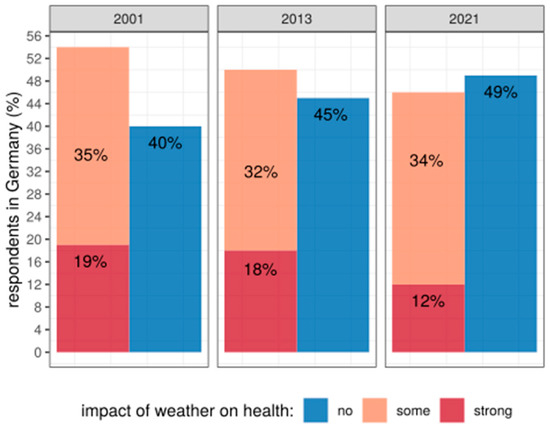
Figure 1.
Impact of weather on the health of the German population aged 16 and over. Data are based on representative surveys conducted by IfD Allensbach (self-assessment by respondents).
In particular, over the period from 2013 to 2021, the group of those who feel a strong impact of weather on their health decreased significantly from 18% to 12%. The percentage of those noting some impact of weather on their health has remained largely constant at 35% in 2001, 32% in 2013, and 34% in 2021.
Based on older studies by IfD Allensbach, the percentage of weather-sensitive individuals has been decreasing continuously since the middle of the 20th century. From 1955 to 1985, the percentage of weather-sensitive individuals in western Germany was consistently between 58% and 63%, thus consistently higher than the percentages in 2001, 2013, and 2021 [6].
3.2. Gender- and Age-Specific Differences among Weather-Sensitive Individuals
An analysis by gender reveals that the proportion of weather-sensitive individuals has decreased in both genders over the past 20 years. In general, however, men are less weather-sensitive than women (Figure 2).
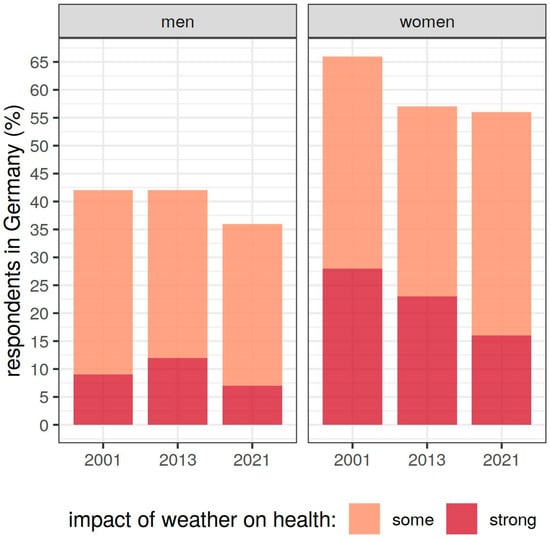
Figure 2.
Development of weather sensitivity among men and women. The data are based on representative surveys conducted by IfD Allensbach (self-assessment by respondents).
In January 2021, 36% of men and 56% of women reported being weather-sensitive. The largest decrease in weather sensitivity among women occurred between 2001 and 2013 and among men between 2013 and 2021. For both genders, the main decrease was in the proportion reporting a strong impact of weather on their health; for women, this proportion decreased consistently from 2001 to 2021.
In addition to women, the survey in 2021 confirms again that older individuals are particularly more sensitive to weather than the average person. From the 16–29-year-olds, 21% reported some impact of weather, and 6% are strongly weather-sensitive. In summary, this connotes that 27% of weather-sensitive individuals are in the younger generation. In contrast, 38% of those 60 and older reported some impact of weather, and 17% reported a strong impact. That sums up to 54% of weather-sensitive individuals being in the older generation (Appendix A, Figure A1).
3.3. First Occurrence of Weather Sensitivity
However, the first occurrence of weather sensitivity is about equally common in all life stages (Table 1).

Table 1.
The first occurrence of weather sensitivity is about equally frequent at all ages. The data are based on representative surveys by the IfD Allensbach (self-assessment by respondents).
Scarcely one in five respondents noticed for the first time that they were sensitive to weather when they were under 20 years old. Likewise, about one in five respondents pinpoint the first occurrence of their weather-related complaints and symptoms to the decade between the age of 20 and 30, and again, scarcely one in five say beyond the age of 50. According to the results of 2021, weather sensitivity occurs less frequently between the age of 30 and 50 for the first time in the two decades.
3.4. Weather Conditions with Negative Impact on Health
According to the survey results of 2021, the question concerning the weather conditions that have a particularly negative impact on health is most frequently answered with “when it gets colder”. In addition, stormy weather and “when it gets warmer” is also perceived with negative impacts on health. These discoveries are in line with the most frequent weather conditions, or rather bio-synoptical classes affecting humans that are applied in the daily medical-meteorological forecasts for Germany by DWD. The strongest impact of weather on health can be found in correspondence to the bio-synoptical classes behind a cold front, in the centre of a cyclone, and ahead of a warm front [9].
3.5. Weather-Associated Complaints and Symptoms
The weather-associated complaints and symptoms suffered by weather-sensitive individuals have remained largely stable over the past 20 years. According to the survey in 2021, weather-sensitive individuals suffer most frequently, regardless of age, from headaches and migraines (62% of weather-sensitive individuals), exhaustion and general fatigue (54%), as well as limited activities and abnormal fatigue (49%) (Figure 3). This is followed by sleep disturbances (37%) and joint pain (36%), respectively, with joint pain in particular increasing with age. Conversely, dejection and petulance are more prevalent among young weather-sensitive individuals than among weather-sensitive individuals of the older generation. Concentration disorders, dizziness, muscular pain, and underachievement occur in just over 20% of weather-sensitive individuals in Germany, with muscular pain being mentioned particularly by those older than 60 years and concentration disorders and underachievement mainly by the younger and medium generations. Scar tissue pain occurs in 18% and hypersensitivity in 17% of weather-sensitive individuals. Flurry, sight disorders, augmented aggressiveness, light-headedness, problems in partnership or with others, and cramps affect the health of weather-sensitive individuals the least (around and under 10%). Those aged 16 to 29 years report augmented aggressiveness significantly more often than all other age groups (~20% of weather-sensitive individuals).
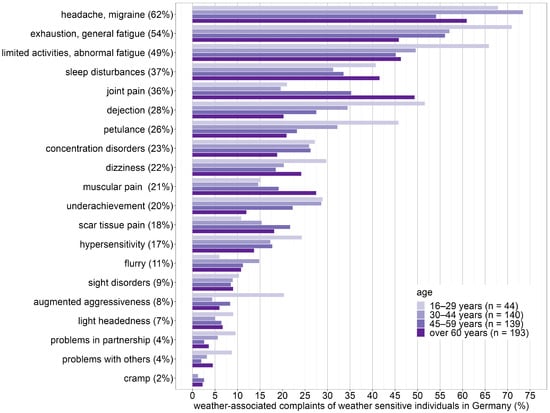
Figure 3.
Percentage of weather-associated complaints and symptoms per age group that occur among weather-sensitive individuals in Germany. The percentages depicted in parentheses occur irrespective of age group. Multiple responses were possible during the survey. The data are based on representative surveys conducted by IfD Allensbach in January 2021 (self-assessment by respondents).
Table 2 reveals the results of Figure 3 additionally in absolute numbers, but it should be considered that it is possible that the same respondent contributed to the absolute number of more than one weather-associated complaint.

Table 2.
Absolute number of reports of weather-associated complaints and symptoms per age group (color is chosen according to Figure 3) that occur among weather-sensitive individuals in Germany. Multiple responses were possible during the survey. Therefore, it is possible that the same respondent reported different weather-associated complaints and thus contributed to the absolute number of more than one weather-associated complaint. The data are based on representative surveys conducted by IfD Allensbach in January 2021 (self-assessment by respondents).
Among weather-sensitive women and weather-sensitive men, weather-related complaints and symptoms sometimes occur with different frequencies. While 70% of weather-sensitive women suffer from headaches and migraines, only 50% of weather-sensitive men are affected by headaches and migraines. Likewise, women suffer more frequently than men from sleep disturbances, petulance, dizziness, scar tissue pain, hypersensitivity, and flurry. In contrast, weather-sensitive men complain more often about limited activities, abnormal fatigue, joint pain, muscular pain, and underachievement than weather-sensitive women (Appendix A, Figure A2).
3.6. Chronic Afflictions and Weather Sensitivity
An unchanged strong relationship persists between the presence of chronic afflictions and the occurrence of weather sensitivity. In 2021, 55% of the respondents with chronic afflictions described themselves as weather-sensitive (40% with some impact of weather on health + 15% with strong impact of weather on health) compared to only 29% of the healthy respondents (24% with some impact of weather on health + 5% with strong impact of weather on health) (Figure 4).
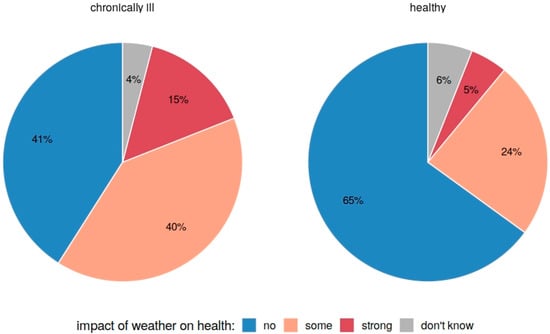
Figure 4.
Chronically ill people are more often weather-sensitive than healthy people. The data are based on representative surveys conducted by IfD Allensbach in January 2021 (respondents’ self-assessment).
The survey results from 2021 also reveal that weather-sensitive individuals suffer from a chronic affliction more frequently than the average population. In 2021, 67% of the respondents that were representative of the total population and 79% of weather-sensitive individuals reported being affected by at least one chronic affliction. Conversely, 33% of the total population does not complain of a single chronic affliction, compared to only 21% of weather-sensitive individuals (Figure 5). Common chronic afflictions such as circulatory disorders, chronic pain, allergy, hay fever, heart disease, respiratory disease, rheumatism, and asthma are listed in Figure 5.
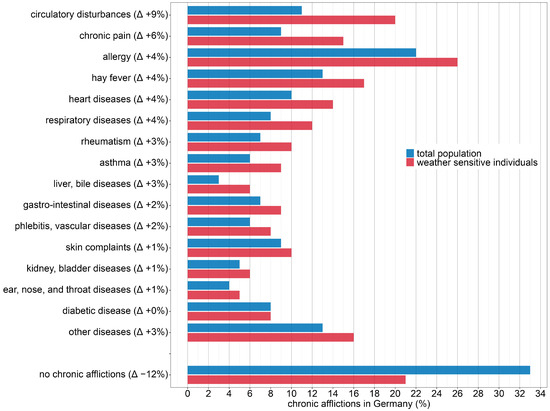
Figure 5.
Occurrence of chronic afflictions in the total population compared to weather-sensitive individuals in Germany. Multiple answers are possible. Weather-sensitive individuals suffer more frequently from chronic afflictions than the average population (∆ = difference between the percentage of weather-sensitive individuals and the percentage of the total population), especially from circulatory diseases (+9% more frequently) and chronic pain (+6% more frequently). The data are based on representative surveys conducted by IfD Allensbach in January 2021 (respondents’ self-assessment).
3.7. Inability to Work
Within the 12 months prior to the survey, 26% of weather-sensitive individuals were unable to perform their jobs, whether at work or at home, due to weather-related symptoms. On average, weather-sensitive individuals were unable to attend work or home duties on about 7 to 8 days per year. Non-workers reported more frequent absences (30%) caused by their weather sensitivity than workers (23%). Compared to the previous two surveys, the weather-related restrictions on the ability to work are also tending to decline.
4. Discussion
The survey results presented are based on self-assessments and are therefore not objective. The 1080 respondents representative of the total population in Germany were interviewed in January 2021. In order to prove whether there is actually a connection between complaints or symptoms and the weather, it is solely possible to have the respondents keep a diary of their health complaints over a longer period of time, which can then be evaluated with regard to the prevailing weather conditions. Certain biotropic weather conditions described by bio-synoptical weather classes (i.e., weather conditions that have a biological impact on humans) could already be identified with the help of statistical investigations and epidemiological studies [7]. The adverse weather conditions mentioned in the surveys are consistent with the biotropic weather conditions mentioned in the literature. However, to date, insufficient scientific studies have been conducted to assess the prevalence of weather sensitivity in the general population. In the UK, the study “Cloudy with a Chance of Pain”, based on an analysis of daily data/diary entries obtained via smartphones from 2658 patients over a 15-month period, concluded that higher humidity, lower pressure, and stronger winds correlated with increased chronic pain [5].
It can be assumed that the actual prevalence in Germany is slightly lower than the survey results presented. One reason for this is the ambiguous definition of weather sensitivity. Due to the nature of the question, people who would possibly not describe themselves as weather-sensitive are added to the weather-sensitive group. Additionally, people who are not weather-sensitive from a medical point of view but describe themselves as weather-sensitive are also included in the group of weather-sensitive individuals. Contemporaneously, it is also likely that weather-associated complaints and symptoms are present in respondents who believe that the weather has no impact on their health or who did not want to commit themselves because etiologically, symptoms of weather sensitivity cannot be distinguished in terms of whether they are weather-related or not. Such symptoms can only be subjectively attributed to the weather or similarly to previous and/or current health conditions [10].
The more pronounced weather sensitivity in women compared to men is physiologically well-grounded, on the one hand due to differences in susceptibility to weather sensitivity, and on the other hand, due to the fact that women and men have different conceptions of health. While men often define health as the “absence of disease”, women more often focus on the aspect of “well-being” [11].
Despite the observed slight decrease in the prevalence of weather sensitivity, the issue of weather sensitivity does not lose its importance, as a large proportion of the population continues to be affected by weather sensitivity. Furthermore, weather sensitivity is also of socioeconomic relevance in terms of the incapacity to work. In addition, the relevance of weather sensitivity will persist in the course of demographic changes, as weather sensitivity is closely coupled with the presence of chronic afflictions and aging. Zacharias and Koppe (2015) also investigated whether the more frequent and severe weather changes expected as a result of climate change, as well as higher thermal loads in summer [12], induce greater stress for the human body. Their results exhibit that rapid temperature changes from the previous day and intraday temperature fluctuations were related to mortality, although the health effect was much smaller than for the effect of absolute values of temperature [9]. Among other factors, the COVID-19 pandemic in 2021 may also have contributed to the declining weather sensitivity, as weather sensitivity also declined significantly in Germany during times of economic hardship, crisis, and war [3].
5. Conclusions
In Germany, the proportion of weather-sensitive individuals reporting that the weather has an impact on their health has decreased slightly from 54% in January 2001 to 50% in January 2013 to 46% in January 2021, according to representative surveys by IfD Allensbach. In particular, the strong impact of weather on health has decreased. Reasons for the decrease in weather sensitivity might be found on the one hand in a stronger health awareness (mainly a stronger health awareness of the older generation, because the strong impact of weather on health primarily affects the older generation), but also in the improvement of health care. The population and especially the older generation attaches more importance to exercise and physical fitness, pays attention to their health status, and together with better eating habits, behaves much more health-consciously. The age limit at which vitality declines and activity levels decrease has shifted significantly over the past two decades. Compared to those aged over 65 twenty or thirty years ago, today’s over-65 act much younger in terms of their behaviour, range of interests, and mentality. However, due to the close relationship between weather sensitivity and chronic afflictions, weather sensitivity will remain an important issue in the future.
Furthermore, new communication possibilities such as websites and smartphone apps offer more accessible information for affected people. They are also extremely helpful to depict facilities on how to treat/allay symptoms and to support behavioural recommendations, specific communication, as well as an increase of environmental awareness.
In addition, there is a greater awareness of stress and sensitivity to environmental factors, such as air pollution control, heat/cold stress factors, and UV exposure, as well as the realization that there are possibilities to prevent weather sensitivity.
Author Contributions
Conceptualization, A.M.; methodology, M.S. and K.G.; software, K.G.; validation, A.M., K.G. and M.S.; formal analysis, M.S. and K.G.; investigation, K.G. and M.S.; resources, K.G. and A.M.; data curation, K.G. and M.S.; writing—original draft preparation, K.G.; writing—review and editing, K.G. and A.M.; visualization, K.G.; supervision, A.M.; project administration, A.M.; funding acquisition, A.M. All authors have read and agreed to the published version of the manuscript.
Funding
This research received no external funding.
Institutional Review Board Statement
Not applicable.
Informed Consent Statement
Informed consent was obtained from all subjects involved in the study.
Data Availability Statement
Not applicable.
Conflicts of Interest
The authors declare no conflict of interest.
Appendix A

Table A1.
Questionnaire 2021 (literally translated into English).
Table A1.
Questionnaire 2021 (literally translated into English).
| Question | Answer |
|---|---|
| Q1: Do you believe that environmental stresses such as water and air pollution have increased in our country in recent years, or do you not? |
|
| After some intermediate questions on other topics: | |
| Q2: Does the weather actually affect how you feel health-wise, or are you not that much dependent on the weather? |
|
| The following questions were asked only to those who had answered a or b in Q2. | |
| Q3: During which weather condition do you particularly notice that the weather has an influence on your health, and that you are sensitive to the weather? Would you say that you notice it particularly … (Only one nomination!) |
|
| Q4: How old were you when you first noticed that you were sensitive to the weather, can you tell me roughly? |
|
| Q5: If you are sensitive to the weather, you can have a wide variety of complaints or mood disorders—here are some of them. Are there any complaints that you suffer from sometimes or more often? 1 |
|
| Q6a: Have you ever felt that bad in the past 12 months that you could no longer do your daily work, for example, at work or in the household, because of your weather sensitivity? |
|
| Q6b: Could you estimate how many days you were unable to work in the past 12 months because of this? | At: …………… Working days Do not know anymore |
| Later on in the interview: | |
| Q7: Chronic afflictions often change the general state of health. For this reason, we would like to know from which of the following diseases you suffer? 1 |
None of the above |
1 Multiple answers are possible for questions 5 and 7.

Table A2.
Changes to questionnaires in 2013 and 2001 compared to questionnaire 2021 (Table A1).
Table A2.
Changes to questionnaires in 2013 and 2001 compared to questionnaire 2021 (Table A1).
| Questionnaire 2013 | Questionnaire 2001 |
|---|---|
| Q1: Do you believe that environmental stresses such as water and air pollution have increased in our country in last 10 years, or do you not? | |
| Q6a: Have you ever felt that bad in the past year 2012 that you could no longer do your daily work, for example, at work or in the household, because of your weather sensitivity? | Q6a: Have you ever felt that bad in the past year 2000 that you could no longer do your daily work, for example, at work or in the household, because of your weather sensitivity? |
| Q6b: And could you add how many days you were unable to work in 2012 because of this? | No question Q6b |
Q7: without the response options:
| Q7: without the response options:
|

Table A3.
Characteristics of the German population according to the official statistics compared to the statistics of the survey in 2021, demonstrating that the survey in 2021 can be assumed to be representative for the German population.
Table A3.
Characteristics of the German population according to the official statistics compared to the statistics of the survey in 2021, demonstrating that the survey in 2021 can be assumed to be representative for the German population.
| Survey 2021 | Official Statistics 1 | |
|---|---|---|
| Regional distribution | ||
| West German states incl. West Berlin East German states incl. East Berlin | 82% 18% | 82% 18% |
| 100% | 100% | |
| Northern Germany | 17% | 17% |
| (Schleswig-Holstein, Hamburg, Lower Saxony, Bremen) | ||
| North Rhine-Westphalia | 21% | 21% |
| Southwest Germany (Hesse, Rhineland-Palatinate, Saarland) | 13% | 13% |
| Baden-Württemberg | 13% | 13% |
| Bavaria | 16% | 16% |
| Berlin | 4% | 4% |
| Northeast Germany (Brandenburg, Mecklenburg-West Pomerania, Saxony-Anhalt) | 8% | 8% |
| Saxony and Thuringia | 8% | 8% |
| 100% | 100% | |
| Size of residence | ||
| <5000 inhabitants 5000 to <20,000 inhabitants 20,000 to <100,000 inhabitants ≥100,000 inhabitants | 15% 27% 28% 30% | 15% 27% 28% 30% |
| 100% | 100% | |
| Gender | ||
| Men Women | 49% 51% | 49% 51% |
| 100% | 100% | |
| Age | ||
| 16–29 years 30–44 years 45–59 years ≥60 years | 17% 21% 27% 35% | 17% 21% 27% 35% |
| 100% | 100% | |
| Occupation | ||
| Economically active population (employed and unemployed) Inactive population | 63% 37% | 62% 38% |
| 100% | 100% | |
| Occupational groups 2 | ||
| Workers Employees Public servants Self-employed and freelancers Inactive population | 12% 41% 4% 6% 37% | 12% 41% 3% 6% 38% |
| 100% | 100% | |
| Marital status | ||
| Married/living together -Men -Women Single Widowed Divorced/living apart | 50% 25% 25% 32% 8% 10% | 50% 25% 25% 32% 8% 10% |
| 100% | 100% | |
| Household size (German resident population aged 16 and over) | ||
| 1 person 2 persons 3 persons 4 persons 5 and more persons | 25% 40% 17% 14% 4% | 25% 40% 16% 14% 5% |
| 100% | 100% |
1 Original and estimated values (for the German resident population aged 16 and over) according to data from official statistics. Source: Microcensus 2019. 2 for employed and unemployed persons (classification of unemployed persons according to last job position).
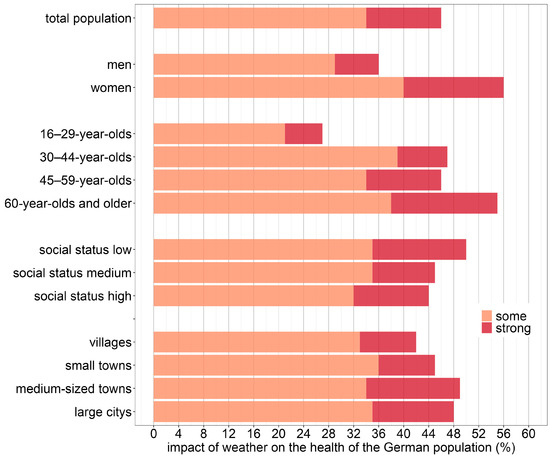
Figure A1.
Differences in weather sensitivity between men and women as well as between the younger and older generation. A total of 27% of the 16–29-year-olds were sensitive to weather. In contrast, 54% of the older individuals were sensitive to weather. This is more frequent than the average.
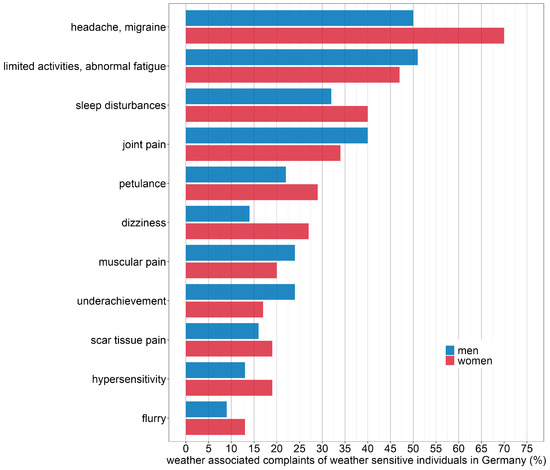
Figure A2.
Different frequencies of weather-associated complaints and symptoms among weather-sensitive women and weather-sensitive men.
References
- Höppe, P.; von Mackensen, S.; Nowak, D.; Piel, E. Prävalenz von Wetterfühligkeit in Deutschland. Dtsch. Med. Wochenschr. 2002, 127, 15–20. [Google Scholar] [CrossRef] [PubMed]
- Zacharias, S. Literaturstudie zum Einfluss des Wetters auf die menschliche Gesundheit. Hg. v. Bundesministerium für Umwelt. Freiburg. 2012. Available online: https://www.bmu.de/fileadmin/Daten_BMU/Pools/Forschungsdatenbank/fkz_3711_61_238_klimawandel_einfluss_bevoelkerung_anlage_1_bf.pdf (accessed on 1 September 2022).
- Faust, V. Biometeorologie—Der Einfluß von Wetter und Klima auf Gesunde und Kranke, 1st ed.; Hippokrates Verlag: Stuttgart, Germany, 1976; ISBN 3-7773-0394-1. [Google Scholar]
- Matzarakis, A. A Note on the Assessment of the Effect of Atmospheric Factors and Components on Humans. Atmosphere 2020, 11, 1283. [Google Scholar] [CrossRef]
- Dixon, W.G.; Beukenhorst, A.L.; Yimer, B.B.; Cook, L.; Gasparrini, A.; El-Hay, T.; Hellman, B.; James, B.; Vicedo-Cabrera, A.M.; Maclure, M.; et al. How the weather affects the pain of citizen scientists using a smartphone app. NPJ Digit. Med. 2019, 2, 105. [Google Scholar] [CrossRef] [PubMed]
- Koppe, C.; Zacharias, S.; Bernhard, D. Repräsentativbefragung zur Wetterfühligkeit in Deutschland. Bericht zum Forschungsvorhaben des Umweltbundesamtes. 2013. Available online: https://www.bmu.de/fileadmin/Daten_BMU/Pools/Forschungsdatenbank/fkz_3711_61_238_klimawandel_einfluss_bevoelkerung_anlage_2_bf.pdf (accessed on 1 September 2022).
- Bucher, K.; Haase, C. Meteorotropy and medical-meteorological forecasts. Experientia 1993, 49, 759–768. [Google Scholar] [CrossRef] [PubMed]
- Floto, C.; Hettwer, H. Wetter und Gesundheit—Gibt es einen Zusammenhang? Ärzteblatt Rheinland-Pfalz, November 1993; pp. 431–434. [Google Scholar]
- Zacharias, S.; Koppe, C. Einfluss des Klimawandels auf die Biotropie des Wetters und die Gesundheit bzw. die Leistungsfähigkeit der Bevölkerung in Deutschland. Bericht zum Forschungsvorhaben des Umweltbundesamtes. UFOPLAN 3711 61 238. 2015. Available online: http://www.umweltbundesamt.de/publikationen/einfluss-des-klimawandels-auf-die-biotropie-des (accessed on 1 September 2022).
- Ranner, R.; Egger, J.W. Das subjektive Wetterfühligkeitssyndrom. Psychol. Med. 1998, 9, 12–20. [Google Scholar]
- Tempel, G.; Jung, F.; Schörder, C. Die Gesundheit von Männern ist nicht die Gesundheit von Frauen. Gesundheitsamt Bremen—Abteilung Gesundheit und Umwelt. 2013. Available online: https://www.roesrath.de/3-gbe-gesundheit-m-e4nner-frauen-gs.pdfx (accessed on 1 September 2022).
- Ebi, K.L.; Capon, A.; Berry, P.; Broderick, C.; de Dear, R.; Havenith, G.; Honda, Y.; Kovats, R.S.; Ma, W.; Malik, A.; et al. Hot weather and heat extremes: Health risks. Lancet 2021, 398, 698–708. [Google Scholar] [CrossRef]
Publisher’s Note: MDPI stays neutral with regard to jurisdictional claims in published maps and institutional affiliations. |
© 2022 by the authors. Licensee MDPI, Basel, Switzerland. This article is an open access article distributed under the terms and conditions of the Creative Commons Attribution (CC BY) license (https://creativecommons.org/licenses/by/4.0/).